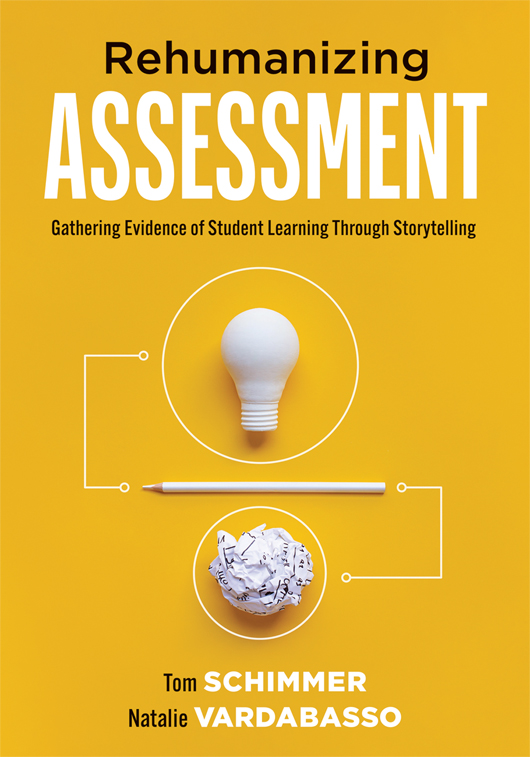Free Reproducibles
Rehumanizing Assessment
Gathering Evidence of Student Learning Through Storytelling
Discover the transformative power of storytelling in assessment and student learning. Drawing on culturally responsive practices, this approach fosters innovation, self-reflection, and student engagement. Through narrative-based strategies, educators can elevate formative and summative assessments, promoting authentic, competency-based learning; meaningful growth; and deeper connections to critical competencies, as well as cultural archetypes. This guide helps educators reimagine assessment in diverse, student-centered classrooms.
Benefits
- Revitalize assessment to encourage students’ growth as critical, creative thinkers
- Elevate student engagement through creative responses and personal reflections
- Employ elements of narrative structure to explore and hone student competencies
- Cultivate student agency and innovation in contemplating and expressing knowledge
- Create opportunities for students to find personal meaning in their learning experiences
TABLE OF CONTENTS
Part 1: Looking Back to Look Forward
Chapter 1: Humanity Through Story
Chapter 2: Essential Assessment Through Story
Chapter 3: Critical Competencies Through Story
Part 2: Learning Through Story
Chapter 4: Conflict Through Story
Chapter 5: Harmony Through Story
Chapter 6: Reflection Through Story
Chapter 7: Perspective Through Story
Chapter 8: Imagination Through Story
Chapter 9: Craft Through Story
Epilogue
PRINTABLE REPRODUCIBLES
Chapter 1: Humanity Through Story
Chapter 2: Essential Assessment Through Story
Chapter 3: Critical Competencies Through Story
- Single-Point Rubric for Creative Thinking (Elementary School)
- Single-Point Rubric for Creative Thinking (Secondary School)
- Chapter 3 Discussion Questions for Learning Teams
Chapter 4: Conflict Through Story
- An Exit Ticket for Reflecting on Conflict Resolution
- Graphic Organizer for Resolving Conflict and Seeking Help
- Chapter 4 Discussion Questions for Learning Teams
Chapter 5: Harmony Through Story
- Graphic Organizer Using the Kishōtenketsu Story Structure to Tell the Story of a Collaborative Endeavor
- Graphic Organizer to Support Peer Dialogue Around the Sailboat Metaphor
- Chapter 5 Discussion Questions for Learning Teams
Chapter 6: Reflection Through Story
- Examples of Loose and Tight Prompts
- Reflection Planning Activity to Prepare for Defense of Learning
- Grading Conference Preparation Form
- Chapter 6 Discussion Questions for Learning Teams
Chapter 7: Perspective Through Story
Chapter 8: Imagination Through Story
- Aspects of Self-Regulated Learning to Scaffold Student Goal Setting
- A Single-Point Rubric for Two Phases of the Creative Process With Possible Student Responses
- Chapter 8 Discussion Questions for Learning Teams
Chapter 9: Craft Through Story
- Questions to Guide the Verification and Implementation Phases of the Creative Process
- A Sample Feedback Checklist Co-Created Between Teacher and Students
- Chapter 9 Discussion Questions for Learning Teams
Epilogue
SUGGESTED RESOURCES
Books
- Almeida, L. (2007). The journey toward effective assessment for English language learners. In D. B. Reeves (Ed.), Ahead of the curve: The power of assessment to transform teaching and learning (pp. 147–163). Solution Tree Press.
- Bellanca, J. A., Fogarty, R. J., & Pete, B. M. (2012). How to teach thinking skills within the Common Core: 7 key student proficiencies of the new national standards. Solution Tree Press.
- Erkens, C., Schimmer, T., & Dimich, N. (2017). Essential assessment: Six tenets for bringing hope, efficacy, and achievement to the classroom. Solution Tree Press.
- Erkens, C., Schimmer, T., & Dimich, N. (2019). Growing tomorrow’s citizens in today’s classrooms: Assessing 7 critical competencies. Solution Tree Press.
- Nottingham, J. (2024). Teach brilliantly: Small shifts that lead to big gains in student learning. Solution Tree Press.
- White, K. (2021). Student self-assessment: Data notebooks, portfolios, and other tools to advance learning. Solution Tree Press.
- Wiliam, D. (2011). Embedded formative assessment. Solution Tree Press.
- Zhao, Y. (2016). The danger of misguided outcomes: Lessons from Easter Island. In Y. Zhao (Ed.), Counting what counts: Reframing education outcomes (pp. 1–10). Solution Tree Press.
Websites
Chapter 2
Chapter 3
Chapter 6
Chapter 9

